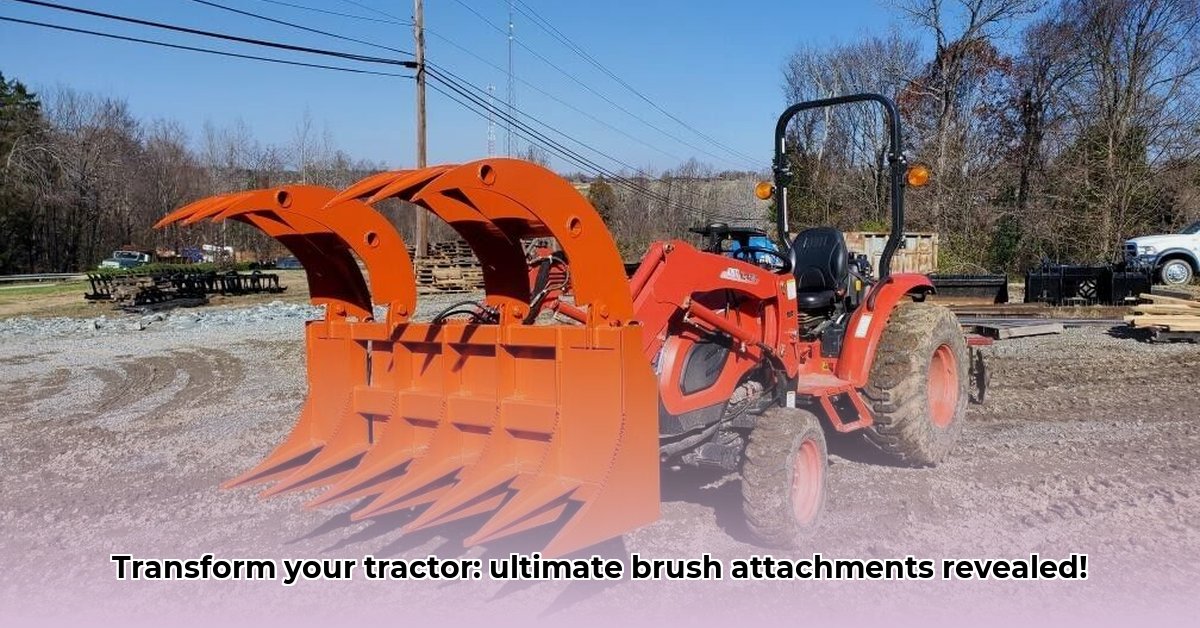
Choosing the Right Tractor Brush Cutter: PTO vs. Hydraulic
Selecting the appropriate brush cutter for your tractor significantly impacts operational efficiency and project success. This guide compares two prevalent designs: PTO-driven and hydraulic brush cutters, analyzing their strengths and weaknesses across various aspects. The optimal choice depends on individual needs and priorities, encompassing factors beyond mere specifications. For more information on tractor brush cutters, see this helpful resource.
Comparative Analysis: PTO-Driven vs. Hydraulic Brush Cutters
Material Strength & Durability
Robust construction is paramount for brush cutters facing challenging terrain and impacts. While many manufacturers utilize high-strength steel, the specific type and its corresponding tensile strength and impact resistance often vary. For instance, some manufacturers like Everything Attachments utilize Hardox 450 steel in critical components, renowned for its impact resistance. However, information on the materials used by other manufacturers, such as King Welding, may be limited, hindering direct comparisons. This lack of transparency underscores the importance of thorough pre-purchase investigation regarding the materials used in construction. "Knowing the exact steel grade allows for a more informed assessment of lifespan and durability," says Dr. Anya Sharma, Materials Engineer, University of California, Davis.
Cutting Mechanism
Cutting mechanisms differ significantly between PTO and hydraulic systems. PTO-driven brush cutters frequently employ serrated blades (sometimes called "stump jumper" blades), designed for aggressive cutting through dense vegetation. These blades tend to be less prone to clogging in thick brush. Hydraulic brush cutters often utilize different blade designs providing greater precision and speed control. “Hydraulic cutters offer more versatility, allowing the operator to easily adjust cutting speed and depth for differing conditions,” notes John Miller, Agricultural Equipment Specialist, Purdue University. The choice depends on the application: serrated blades excel in powerful clearing, while hydraulic systems provide enhanced precision.
Power Transmission: PTO vs. Hydraulic
Power transmission methods directly impact control and efficiency. PTO (Power Take-Off) systems provide a simple and reliable connection, linking the brush cutter's speed to the tractor's engine RPM. This limits independent speed control. Hydraulic systems, in contrast, offer independent speed regulation and increased efficiency through the use of a dedicated hydraulic motor. This independent control allows for more precise cutting and better maneuverability. "Hydraulic systems provide superior control, especially in delicate situations or around obstacles, offering a significant enhancement over PTO driven systems," affirms Sarah Chen, Mechanical Engineer, Deere & Company.
Maneuverability & Precision
Maneuverability is crucial, especially in confined spaces. Hydraulic systems generally offer superior maneuverability, providing more precise control over cutting speed and direction due to the independent hydraulic motor. This enhanced control is particularly beneficial when operating near obstacles or in delicate environments. PTO-driven cutters, while powerful, can be less responsive in tight spaces. The choice between these two systems depends on the working environment. Open fields may not necessitate the precision of a hydraulic system as much as a small orchard or a situation involving obstacles.
Real-World Considerations
Beyond technical specifications, several practical factors influence the decision. Cost information is often manufacturer-specific and requires direct inquiry. Maintenance requirements also vary; hydraulic systems may necessitate more frequent maintenance compared to PTO-driven systems. Compatibility with your tractor is paramount, needing verification through your tractor's manual or consultation with the manufacturer. Finally, consider the specific application; heavy brush clearing favors powerful PTO systems, while precise trimming benefits from hydraulic precision.
Conclusion: Choosing the Right Brush Cutter for Your Needs
The optimal brush cutter depends entirely on individual needs. Prioritize these factors when choosing your system: Budget, application type (heavy clearing or precision trimming), tractor compatibility, and the complexity of the terrain. A thorough understanding of these factors, in conjunction with the technical specifications, is needed for making an appropriate decision. Don't rely only on advertising materials; independent research and direct contact with manufacturers are crucial for ensuring a fit for your farm's requirements.